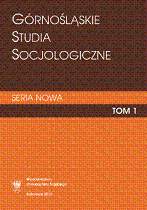Województwo śląskie - szanse dla regionu historycznego pogranicza w XX wieku
Silesian Voivodeship - chances for historical borderland in the 20th century
Author(s): Ryszard KaczmarekSubject(s): Social Sciences
Published by: Wydawnictwo Uniwersytetu Śląskiego
Keywords: Upper Silesia; Silesian Voivodeship; 20th century borderland
Summary/Abstract: In this article the author tries to estimate chances for the borderland of Upper Silesia created by modern European regional politics. From a historical point of view it can be said that there are two kinds of territories, i.e. those playing a central role in the consolidation of adjacent lands (great nations and big countries were created of such territories). The second are called borderlands, where we deal with the lack of both uniformity and centralization. These are known to make a mixture of different elements and cultural influences. Modern Silesian Voivodeship belongs to the second category, in which the problem of integration is currently perceived from a perspective of historical heritage. Thoughtless aspiration to achieve integration at all costs will lead to unnecessary social conflicts as well as arguments in the power elites, but what is the most important it will impoverish the region. Due to considerable regional diversity and transfer of ideas the borderland is seen as culturally attractive, with its dynamic economy and creativity in adopting new patterns of behaviour as well as political visions. Present Silesian Voivodeship is this kind of territory. On the one hand it is an interesting mixture of a national state model, but on the other hand it draws on the experience of historical heritage of patterns, ideas, traditions, which should create a natural bond between inhabitants of common Europe. Although nowadays we talk about chances for the borderland, in the 20th century this region was considered to be problematic. In terms of international relations the region was a controversial issue, which was known as a ‘bleeding border’. As far as domestic politics of both Germany (Kulturkampf ) and later Poland (autonomy, settling accounts with the past after the II World War) are concerned, the borderland was seen as a difficult topic as well. At present, the variety of traditions of European borderland should not be treated as a burden. The development of these regions is dependent on the ability to answer the out-of-date question: Is there a desperate need to integrate (i.e. to unify) those regions into homogeneous national state? The Silesian Voivodeship will make use of this opportunity if the past is seen as a rich multicultural heritage and not as a burden of ‘Silesian tragedy’.
Journal: Górnośląskie Studia Socjologiczne. Seria Nowa
- Issue Year: 2010
- Issue No: 1
- Page Range: 52-69
- Page Count: 18
- Language: Polish

